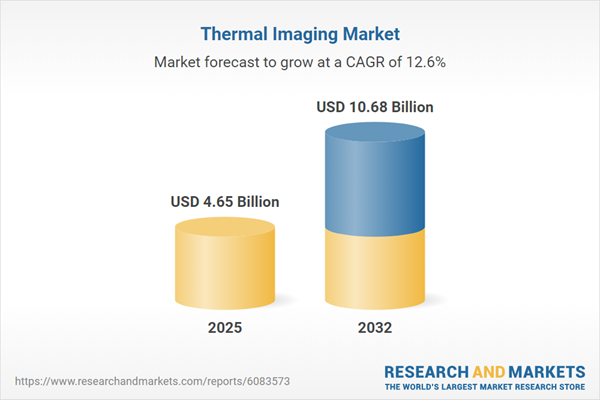Speak directly to the analyst to clarify any post sales queries you may have.
The thermal imaging market is evolving rapidly, driven by the integration of smart technologies, rising safety requirements, and expanding adoption in diverse sectors. Senior leaders are increasingly prioritizing these solutions to enable data-driven, resilient, and future-ready operations.
Market Snapshot: Thermal Imaging Market Size and Growth Trajectory
The global thermal imaging market grew from USD 4.14 billion in 2024 to USD 4.65 billion in 2025. It is projected to expand at a CAGR of 12.57% and reach USD 10.68 billion by 2032. This growth is fueled by advancements in detector technologies, integration with AI and Internet of Things (IoT) platforms, and rising demand for non-invasive diagnostics, predictive maintenance, and advanced surveillance across industries.
Scope & Segmentation: Thermal Imaging Technology and Applications
- Offering Type: Hardware (cooled systems—LWIR, MWIR, SWIR; uncooled systems), services (consulting, integration, maintenance), and software (analysis tools, monitoring solutions, reporting platforms)
- Technology: InGaAs, microbolometer (ASI, VOx), QWIP
- Distribution Channel: Direct sales, system integrators, VAR, OEM, online retail
- End Use: Commercial (corporate, critical infrastructure), government and defense (border security, homeland security, military), industrial, residential
- Application: Automotive (blind spot detection, driver assist, night vision—driver and road monitoring), building inspection, consumer electronics, healthcare, industrial inspection (predictive maintenance, process monitoring, quality control), research and development, security and surveillance (crowd analytics, intrusion detection, perimeter monitoring)
- Regional Coverage: Americas (United States, Canada, Mexico, Brazil, Argentina, Chile, Colombia, Peru), EMEA (United Kingdom, Germany, France, Russia, Italy, Spain, Netherlands, Sweden, Poland, Switzerland, UAE, Saudi Arabia, Qatar, Turkey, Israel, South Africa, Nigeria, Egypt, Kenya), Asia-Pacific (China, India, Japan, Australia, South Korea, Indonesia, Thailand, Malaysia, Singapore, Taiwan)
- Company Coverage: Teledyne Technologies Incorporated, Fortive Corporation, Hikvision Digital Technology Co., Ltd., Axis Communications AB, Opgal Optronics Industries Ltd., Leonardo S.p.A., L3Harris Technologies Inc., Xenics NV, Jenoptik AG, Micro-Epsilon Messtechnik GmbH & Co. KG
Key Takeaways: Strategic Insights for Senior Decision-Makers
- Convergence of AI and IoT with thermal imaging is elevating operational efficiency, enabling real-time anomaly detection and predictive maintenance.
- Business models increasingly emphasize integrated hardware-software-service ecosystems, laying the groundwork for recurring revenue and stronger customer engagement.
- The miniaturization of sensor components and advances in detector materials are facilitating the deployment of compact, portable solutions for diverse field use.
- Market expansion is highly influenced by regional regulatory priorities and investment in energy, infrastructure, and healthcare modernization.
- Collaborative innovations—such as OEM partnerships, software analytics integration, and managed service offerings—are redefining value and competitive positioning across the value chain.
Tariff Impact: Navigating Supply Chain and Procurement Realities
Recent adjustments in United States tariffs on imported infrared detectors, precision optics, and finished thermal cameras are altering procurement dynamics. Industry players are responding by diversifying suppliers, near-shoring production, and renegotiating supply agreements to manage cost pressures and logistics complexities. These measures reinforce the strategic significance of agile procurement approaches and collaborative partnership models for sustainable market participation.
Methodology & Data Sources
This analysis combines primary interviews with industry executives, engineers, and end users, alongside a systematic review of technical literature, regulatory updates, and market reports. Expert validation workshops and analytical frameworks ensure robust interpretation and accuracy, giving decision-makers confidence in strategic findings and segmented recommendations.
Why This Report Matters: Actionable Guidance for Business Leaders
- Enables precise alignment of investment, technology adoption, and go-to-market strategies through structured market segmentation and regional insights.
- Empowers executive teams with an understanding of shifting supplier dynamics and tariff impacts, supporting resilience and risk mitigation.
Conclusion
Thermal imaging is moving from specialized sectors into core operational systems across industries. Strategic technology adoption, resilient supply chains, and ecosystem partnerships will enable leaders to capture growth and adapt to evolving market demands.
Table of Contents
3. Executive Summary
4. Market Overview
7. Cumulative Impact of Artificial Intelligence 2025
Companies Mentioned
The companies profiled in this Thermal Imaging market report include:- Teledyne Technologies Incorporated
- Fortive Corporation
- Hikvision Digital Technology Co., Ltd.
- Axis Communications AB
- Opgal Optronics Industries Ltd.
- Leonardo S.p.A.
- L3Harris Technologies, Inc.
- Xenics NV
- Jenoptik AG
- Micro-Epsilon Messtechnik GmbH & Co. KG
Table Information
| Report Attribute | Details |
|---|---|
| No. of Pages | 197 |
| Published | October 2025 |
| Forecast Period | 2025 - 2032 |
| Estimated Market Value ( USD | $ 4.65 Billion |
| Forecasted Market Value ( USD | $ 10.68 Billion |
| Compound Annual Growth Rate | 12.5% |
| Regions Covered | Global |
| No. of Companies Mentioned | 11 |









